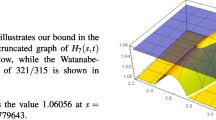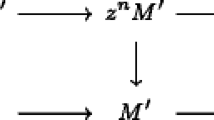Abstract
Let R be an excellent Noetherian ring of prime characteristic. Consider an arbitrary nested pair of ideals (or more generally, a nested pair of submodules of a fixed finite module). We do not assume that their quotient has finite length. In this paper, we develop various sufficient numerical criteria for when the tight closures of these ideals (or submodules) match. For some of the criteria we only prove sufficiency, while some are shown to be equivalent to the tight closures matching. We compare the various numerical measures (in some cases demonstrating that the different measures give truly different numerical results) and explore special cases where equivalence with matching tight closure can be shown. All of our measures derive ultimately from Hilbert–Kunz multiplicity.
Similar content being viewed by others
Notes
We remark here that by the methods used in proving our Theorem 2.4, the assumption that \(\hat{R}\) is reduced is unnecessary.
Note that rings with FFRT need not be F-regular (or even F-rational). Shibuta [29] proved that if R is any 1-dimensional complete local domain of prime characteristic whose residue field is either finite or algebraically closed, then R has finite F-representation type.
Here too, the reducedness assumption appears to be unnecessary, in light of methods used in the proof of Theorem 2.4.
Recent work of Polstra [24] indicates that this limit exists in some generality, as well as the other limits defined in this section and the next.
References
Aberbach, I.M.: The existence of the F-signature for rings with large \(\mathbb{Q}\)-Gorenstein locus. J. Algebra 319(7), 2994–3005 (2008)
Achilles, R., Manaresi, M.: Multiplicity for ideals of maximal analytic spread and intersection theory. J. Math. Kyoto Univ. 33(4), 1029–1046 (1993)
Achilles, R., Manaresi, M.: Multiplicities of a bigraded ring and intersection theory. Math. Ann. 309(4), 573–591 (1997)
Brenner, H.: Irrational Hilbert-Kunz multiplicities. arXiv:1305.5873 (2013)
Brenner, H., Monsky, P.: Tight closure does not commute with localization. Ann. of Math. (2) 171(1), 571–588 (2010)
Buchsbaum, D.A., Eisenbud, D.: What makes a complex exact? J. Algebra 25, 259–268 (1973)
Dao, H., Smirnov, I.: On generalized Hilbert–Kunz function and multiplicity. arXiv:1305.1833 (2013)
Dao, H., Watanabe, K.: Some computations of generalized Hilbert–Kunz function and multiplicity. arXiv:1503.00894 (2015)
Epstein, N.: Phantom depth and stable phantom exactness. Trans. Am. Math. Soc. 359(10), 4829–4864 (2007)
Epstein, N., Yao, Y.: Criteria for flatness and injectivity. Math. Z. 271(3–4), 1193–1210 (2012)
Epstein, N., Yao, Y.: A computation concerning relative Hilbert–Kunz multiplicities. arXiv:1605.01807 (2016)
Flenner, H., Manaresi, M.: A numerical characterization of reduction ideals. Math. Z. 238(1), 205–214 (2001)
Hochster, M., Huneke, C.: Tight closure, invariant theory, and the Briançon-Skoda theorem. J. Am. Math. Soc. 3(1), 31–116 (1990)
Hochster, M., Huneke, C.: \(F\)-regularity, test elements, and smooth base change. Trans. Am. Math. Soc. 346(1), 1–62 (1994)
Hochster, M., Huneke, C.: Localization and test exponents for tight closure. Michigan Math. J. 48, 305–329 (2000)
Huneke, C.: Tight Closure and its Applications. In: CBMS Reg. Conf. Ser. in Math., vol. 88, Amer. Math. Soc., Providence (1996)
Huneke, C., Leuschke, G.J.: Two theorems about maximal Cohen–Macaulay modules. Math. Ann. 324(2), 391–404 (2002)
Katzman, M., Sharp, R.Y.: Uniform behaviour of the Frobenius closures of ideals generated by regular sequences. J. Algebra 295(1), 231–246 (2006)
Kurano, K.: The singular Riemann–Roch theorem and Hilbert–Kunz functions. J. Algebra 304(1), 487–499 (2006)
Lam, T.Y.: A First Course in Noncommutative Rings. Graduate Texts in Mathematics. Springer, New York (1991)
Lyubeznik, G.: \(F\)-modules: applications to local cohomology and \(D\)-modules in characteristic \(p>0\). J. Reine Angew. Math. 491, 65–130 (1997)
Monsky, P.: The Hilbert–Kunz function. Math. Ann. 263(1), 43–49 (1983)
Peskine, C., Szpiro, L.: Dimension projective finie et cohomologie locale. applications à la démonstration de conjectures de M. Auslander, H. Bass et A. Grothendieck, Inst. Hautes Études Sci. Publ. Math. 42, 47–119 (1973)
Polstra, T.: Uniform bounds in F-finite rings and lower semi-continuity of the F-signature. arXiv:1506.01073, (2015)
Seibert, G.: Complexes with homology of finite length and Frobenius functors. J. Algebra 125(2), 278–287 (1989)
Sharp, R.Y.: Graded annihilators of modules over the Frobenius skew polynomial ring, and tight closure. Trans. Am. Math. Soc 359(9), 4237–4258 (2007) (electronic)
Sharp, R.Y.: On the Hartshorne-Speiser-Lyubeznik theorem about Artinian modules with a Frobenius action. Proc. Am. Math. Soc. 135(3), 665–670 (2007) (electronic)
Sharp, R.Y., Nossem, N.: Ideals in a perfect closure, linear growth of primary decompositions, and tight closure. Trans. Am. Math. Soc. 356(9), 3687–3720 (2004)
Shibuta, T.: One-dimensional rings of finite \(F\)-representation type. J. Algebra 332(1), 434–441 (2011)
Smith, K.E., van der Bergh, M.: Simplicity of rings of differential operators in prime characteristic. Proc. Lond. Math. Soc. 75(1), 32–62 (1997)
Ulrich, B., Validashti, J.: Numerical criteria for integral dependence. Math. Proc. Camb. Philos. Soc. 151(1), 95–102 (2011)
Vraciu, A.: An observation on generalized Hilbert-Kunz functions. arXiv:1510.00668, (2015)
Yao, Y.: Modules with finite \(F\)-representation type. J. Lond. Math. Soc. 2(72), 53–72 (2005)
Yoshino, Y.: Skew-polynomial rings of Frobenius type and the theory of tight closure. Comm. Algebra 22(7), 2473–2502 (1994)
Author information
Authors and Affiliations
Corresponding author
Additional information
The second author was partially supported by the National Science Foundation DMS-0700554.
Rights and permissions
About this article
Cite this article
Epstein, N., Yao, Y. Some extensions of Hilbert–Kunz multiplicity. Collect. Math. 68, 69–85 (2017). https://doi.org/10.1007/s13348-016-0174-2
Received:
Accepted:
Published:
Issue Date:
DOI: https://doi.org/10.1007/s13348-016-0174-2




